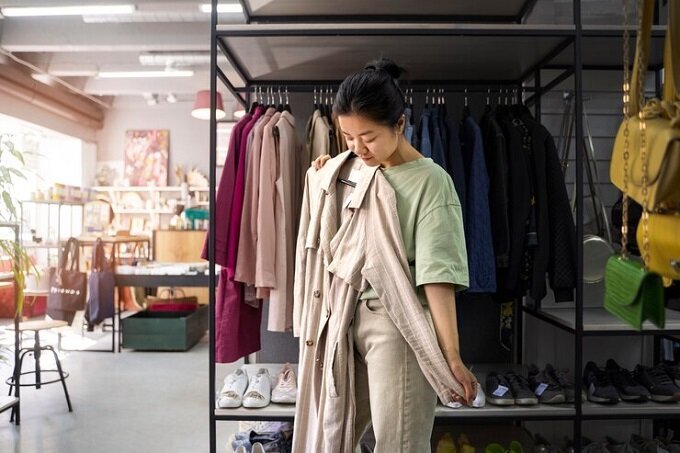The fashion industry, with its flashy trends and ever-changing styles, has a dark underbelly—an environmentally and socially destructive side that needs addressing. Sustainable fashion is a movement challenging the status quo, offering an eco-friendly and ethical alternative to the detrimental practices of the fast-paced, trend-driven fashion world.
In this comprehensive guide, we will dive into the world of sustainable fashion, exploring its importance, and offering practical tips for building a wardrobe that is kind to both the planet and its people. From understanding the impact of the fashion industry to discovering sustainable brands and practices, this article will empower you to make conscious fashion choices that contribute to a greener future.
So, are you ready to embark on a journey towards a more sustainable and ethical wardrobe? Let’s get started!
What is Sustainable Fashion?
At its core, sustainable fashion, or eco-fashion, revolves around creating environmentally and socially responsible clothing. It considers the entire lifecycle of a garment, from the sourcing of raw materials to the production, distribution, and eventual disposal of the item. Sustainable fashion aims to minimize the fashion industry’s negative impact and promote ethical practices, including:
- Ethical Production: Ensuring fair wages, safe and healthy working conditions, and the elimination of child labor and exploitation.
- Sustainable Materials: Using eco-friendly, biodegradable, and recycled fabrics, such as organic cotton and recycled polyester, to reduce the industry’s reliance on non-renewable resources.
- Responsible Waste Management: Implementing recycling and upcycling initiatives to keep textile waste out of landfills, thereby reducing the industry’s overall environmental footprint.
- Transparency and Accountability: Fostering transparency in the supply chain and holding brands accountable for their environmental and social impact.
By adopting these principles, the goal is to create a fashion industry that is circular and regenerative, one that respects the rights and well-being of workers, communities, and the planet.
The Importance of Sustainable Fashion
With the fashion industry contributing to about 10% of global carbon emissions and being a significant polluter of water and a driver of deforestation, the need for sustainable practices is undeniable. The rise of fast fashion, with its cheap, quickly produced, and disposable clothing, has only exacerbated these issues. Sustainable fashion offers a range of benefits and solutions:
- Reducing Environmental Impact: Eco-friendly materials and responsible waste management practices can significantly lower the industry’s carbon and water footprint and decrease pollution levels.
- Promoting Ethical Labor Practices: Ensuring fair wages and safe working conditions, sustainable fashion supports the well-being and rights of garment workers, eliminating exploitative labor practices.
- Encouraging Mindful Consumption: Sustainable fashion encourages consumers to opt for quality over quantity, investing in long-lasting, versatile pieces, and moving away from the throwaway culture.
- Inspiring Innovation: The shift towards sustainability has sparked innovation in materials, production methods, and business models, with a new focus on environmental and social responsibility.
Sustainable Fashion Practices
Sustainable fashion is more than just a concept; it’s a set of tangible practices that aim to reduce the industry’s environmental and social impact. Here are some key sustainable fashion practices to look out for:
- Ethical Production: Prioritizing ethical production methods, sustainable brands ensure fair wages and safe, healthy working conditions throughout their supply chains, partnering with certified factories and conducting regular audits.
- Sustainable Materials: Eco-friendly, biodegradable, and recycled fabrics are at the heart of sustainable fashion. Organic cotton, linen, hemp, and recycled polyester are examples of materials that reduce the industry’s environmental footprint and minimize waste.
- Slow Fashion: In contrast to fast fashion, slow fashion encourages consumers to buy fewer, higher-quality, long-lasting garments, moving away from constant consumption and disposal.
- Circular Fashion: Circular fashion promotes a closed-loop system, emphasizing the reuse, repair, and recycling of clothing to extend the lifespan of garments and minimize waste.
- Transparency and Traceability: Sustainable brands provide detailed information about their supply chains, production methods, and environmental and social impact, empowering consumers to make informed choices.
- Responsible Waste Management: Recycling and upcycling initiatives are key, keeping textile waste out of landfills and giving new life to old garments.
- Advocacy and Education: Sustainable fashion brands and organizations actively raise awareness about the industry’s impact and educate consumers and industry players about more sustainable practices.
Sustainable Fashion Brands and Certifications
The good news is that an increasing number of brands are embracing the challenge of sustainability. Here are some examples of sustainable fashion brands and the certifications they may hold:
- Organic Cotton: Patagonia, Pact, and Eileen Fisher are examples of brands using certified organic cotton, grown without harmful pesticides and synthetic fertilizers.
- Recycled Materials: Everlane, Girlfriend Collective, and Reformation are pioneers in using recycled materials, such as recycled polyester and nylon, reducing waste and minimizing the use of virgin resources.
- Certified B Corporations: Eileen Fisher, Patagonia, and Reformation are among the brands with the prestigious B Corporation certification, meeting rigorous standards of social and environmental performance and transparency.
- Fair Trade Certification: Brands like Pact and Synergy Organic Clothing ensure fair wages and safe working conditions for their garment workers through Fair Trade certification, which also promotes community development.
- Global Organic Textile Standard (GOTS): GOTS is a leading certification for organic textiles, ensuring the use of organic fibers and environmentally and socially responsible production methods.
- Cradle to Cradle Certification: This certification evaluates a product’s design and manufacturing process for environmental and social impact, encouraging a circular approach.
Building Your Eco-Friendly Wardrobe
Making the switch to a sustainable wardrobe is easier than you think. Here’s a simple guide to help you get started:
- Prioritize Quality over Quantity: Invest in well-made, timeless pieces that will last for years. This reduces waste and supports a more sustainable industry.
- Choose Sustainable Materials: Opt for clothing made from eco-friendly fabrics like organic cotton, linen, hemp, and recycled polyester. Avoid synthetic fabrics derived from non-renewable resources, which can contribute to microplastic pollution.
- Support Ethical Brands: Research the production practices and labor policies of brands. Look for certifications like Fair Trade, B Corp, and GOTS to ensure your purchases support ethical and sustainable practices.
- Embrace Secondhand and Vintage: Shopping secondhand extends the life of existing garments and reduces textile waste. Explore thrift stores, consignment shops, and online platforms for unique, pre-loved finds.
- Rent or Borrow: For special occasions or short-lived trends, consider renting or borrowing clothing instead of buying new.
- Care for Your Clothes: Proper clothing care, such as washing in cold water and air-drying, can extend the lifespan of your garments and reduce the environmental impact of laundering.
- Recycle and Upcycle: When it’s time to part with a garment, explore recycling or upcycling options to give it new life instead of sending it to a landfill.
Conclusion
The fashion industry’s impact on the environment and social well-being is significant, but sustainable fashion offers a promising path forward. By embracing ethical production, sustainable materials, and mindful consumption, we can create a circular and regenerative fashion industry that respects people and the planet.
As consumers, we have the power to drive this change by making conscious fashion choices and supporting sustainable brands. Together, let’s build a future where fashion is not only about style but also about sustainability, ethics, and positive impact. So, will you join the journey towards a greener wardrobe?



